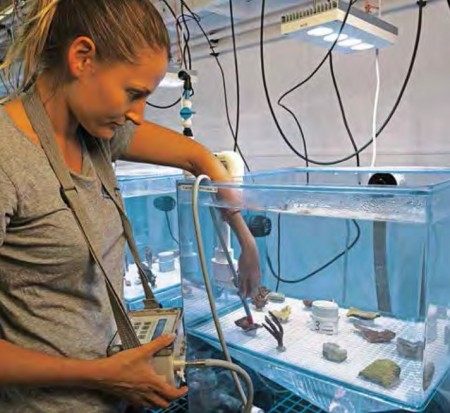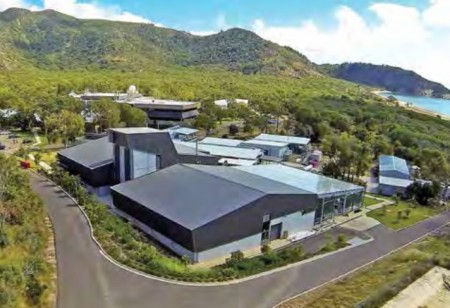November 2, 2015 – In a place called SeaSim, Australian and international teams of scientists are studying coral reefs in conditions that simulate the potential changes that climate change will bring to the world’s oceans. SeaSim stands for the National Sea Simulator, a facility that features 33 processing tanks and storage capacity for 3,650,000 liters (964,000 U.S. gallons) of seawater. The variables being studied include changes in salinity, acidity, sedimentation, pollutants and contaminants, light and temperature. In this environment the scientists are breeding coral to see if different strains are better adapted to handle thermal stress, increased acidity and changes to sea level.
Australia’s offshore is home to the world’s largest concentration of coral reefs including the Great Barrier Reef off its east coast. This reef in particular is the canary in the coal mine for the oceans. It stretches 2,300 kilometers (more than the distance between Washington, D.C. and Rapid City, South Dakota). It is home to 600 species of soft and hard corals, 3,000 varieties of mollusks, 500 species of sea worms, 100 types of jellyfish, 133 varieties of sharks and rays, 30 species of whales and dolphins and 1,625 different species of fish. It contains within it 3,000 distinct coral reefs, 150 mangrove islands, and 300 coral cays. At its widest it stretches 250 kilometers (155 miles). Depth of the reef varies from 35 to 2,000 meters (115 to 6,560 feet).
The Australian government constantly monitors the reef through its Eye on the Reef network. In its most recent reports between December 2014 and the end of April 2015, the government conducted 940 health impact surveys on 81 individual reefs within the reef complex. In these surveys one third reported disease or bleaching impacts with 43% reporting at least one of the two in evidence. In four cases, the surveys showed severe damage indicating multiple coral colonies destroyed. And in two cases, extreme damage was reported impacting the structural integrity of the reef itself. In 16% of the surveys the corals displayed evidence of disease with coral bleaching visible in 8%. Coral bleaching, which also goes by the name, white syndrome, is a phenomena associated with reef death. Higher temperatures and increased carbon dioxide content in the ocean causing pH levels to drop are known agents that cause white syndrome and coral mortality.
That’s why SeaSim is testing a wide variety of coral species in its system of seawater tanks. For the coral, reproduction is usually a once a year phenomenon, but at Sea Sim, every 3 months the researchers produce 30,000 new coral larvae. This gives them the opportunity to do multi-generational studies within the confines of the tanks while they vary the conditions to which the coral are subject. The goal is to identify coral tolerance thresholds when exposed to climate change including thermal, acidification, sedimentation and disease stresses.
Which brings us to the project that SeaSim calls assisted evolution. The hope is to actively manipulate the genetic composition of native coral populations to accelerate evolutionary processes that allow the reefs to adapt to the changing conditions of the ocean brought about by global warming. Creating corals that can adapt to increased temperatures, acidification and changing biomes brought about by new ocean conditions may be the best way to go about saving the Great Barrier Reef and other coral reefs around the world. The SeaSim experiments measure variation in coral fitness traits in response to single and compound climate stressors. Genomic analysis is identifying the genetic markers of corals that handle these stressors. Knowing the right genes may lead to the production of genetically modified coral populations resistant to the worst that climate change can offer.
SeaSim isn’t limited to looking at climate change and its impact on coral. The scientists are also studying how dredging and sedimentation changes alter coral health, how coal and oil spills impact coral spawning and reef health, and how chemical pollutants such as pesticides interact with coral.
Australia recently invited scientists from around the world to propose new research projects at the SeaSim facility indicating that they were reserving 50% of capacity for international contributors to the study of coral and its future. An adaptation strategy like this may prove to be a lifesaver for coral reversing the observed decline in reefs across the oceans of the world. Time will tell.

















